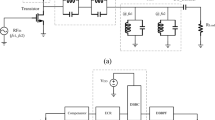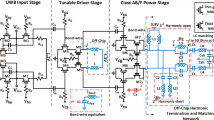Abstract
In this paper, concurrent-mode operation of dual-band PAs under simultaneous drive of two stimuli is investigated. It is shown that Class-J operation is well suited for this mode of operation as its concurrent-mode efficiency is less affected by the load reactance tuning accuracy at inter-modulation frequencies. This characteristic results in preserved efficiencies over wider bandwidths, and simplicity of intermodulation tuning network (IMTN) realization. It has been also shown that dual-band Class-J/J PA fully takes advantage of the transistor’s nonlinear output capacitance in case of simultaneously driven input by boosting the efficiency. A Class-J/J concurrent dual-band PA with IMTN is designed and implemented which operates over 1.842/2.655 GHz bands. About 40 dBm output power and efficiencies more than 70% at lower band and upper band are obtained according to the experimental results while the concurrent-mode efficiency is about 61.2%.









Similar content being viewed by others
Data Availability
The datasets generated during and/or analyzed during the current study are available from the corresponding author on reasonable request.
Code Availability
The codes generated during the current study are available from the corresponding author on reasonable request.
References
Kumar, S., Kanaujia, B. K., Dwari, S., et al. (2017). 11–17 GHz reconfigurable stacked power amplifier using matched slant microstrip line for Ku band application. Wireless Personal Communications, 92, 1771–1785.
Rezaei Borjlu, S., Dousti, M., & Asemani, D. (2018). Concurrent dual-band Doherty power amplifier using a novel dual-band bandpass filter for wireless technologies. Analog Integrated Circuits and Signal Processing, 96, 395–408.
Fu, X., Bespalko, D. T., & Boumaiza, S. (2014). Novel dual-band matching network for effective design of concurrent dual-band power amplifiers. IEEE Transactions on Circuits and Systems I: Regular Papers, 61(1), 293–301.
Alizadeh, A., Frounchi, M., & Medi, A. (2017). Dual-band design of integrated class-J power amplifiers in GaAs pHEMT technology. IEEE Transactions on Microwave Theory and Techniques, 65(8), 3034–3045.
Chen, W., Zhang, S., Liu, Y., Liu, Y., & Ghannouchi, F. M. (2014). A concurrent dual-band uneven Doherty power amplifier with frequency-dependent input power division. IEEE Transactions on Circuits and Systems I: Regular Papers, 61(2), 552–561.
Chen, X., Chen, W., Ghannouchi, F. M., Eng, Z., & Liu, Y. (2013). Enhanced analysis and design method of concurrent dual-band power amplifiers with intermodulation impedance tuning. IEEE Transactions on Microwave Theory and Techniques, 61(12), 4544–4558.
Saxena, S., Rawat, K., & Roblin, P. (2017). Continuous class-B/J power amplifier using a nonlinear embedding technique. IEEE Transactions on Circuits and Systems II: Express Briefs, 64(7), 837–841.
Shariatifar, M., Jalali, M., & Abdipour, A. (2018). A methodology for designing class-F − 1/J (J − 1) high efficiency concurrent dual-band power amplifier. Microelectronics Journal, 81, 1–7.
Poluri, N., & De Souza, M. M. (2018). Investigation of the effect of weak non-linearities on P1dB and efficiency of class B/J/J* amplifiers. IEEE Transactions on Circuits and Systems II: Express Briefs, 65(9), 1159–1163.
Jee, S., Moon, J., Kim, J., Son, J., & Kim, B. (2012). Switching behavior of class-E power amplifier and its operation above maximum frequency. IEEE Transactions on Microwave Theory and Techniques, 60(1), 89–98.
Alizadeh, A., Yaghoobi, M., & Medi, A. (2017). Class-J2 power amplifiers. IEEE Transactions on Circuits and Systems I: Regular Papers, 64(8), 1989–2002.
Seo, M., et al. (2014). High-efficiency power amplifier using an active second-harmonic injection technique under optimized third-harmonic termination. IEEE Transactions on Circuits and Systems II: Express Briefs, 61(8), 549–553.
Tasker, P. J., & Benedikt, J. (2011). Waveform inspired models and the harmonic balance emulator. IEEE Microwave Magazine, 12(2), 38–54.
Colantonio, P., Giannini, F., Giofre, R., & Piazzon, L. (2008). A design technique for concurrent dual-band harmonic tuned power amplifier. IEEE Transactions on Microwave Theory and Techniques, 56(11), 2545–2555.
Acknowledgements
This work was supported in part by Iran National Science Foundation (INSF).
Author information
Authors and Affiliations
Contributions
The authors contribute to the work according to the order of their names.
Corresponding author
Ethics declarations
Conflict of interest
The authors have not disclosed any competing interests.
Additional information
Publisher's Note
Springer Nature remains neutral with regard to jurisdictional claims in published maps and institutional affiliations.
Rights and permissions
About this article
Cite this article
Shariatifar, M., Jalali, M. & Abdipour, A. Investigating Concurrent-Mode Operation of Dual-Band Class-J/J Power Amplifiers: Analysis and Design Technique. Wireless Pers Commun 126, 1431–1442 (2022). https://doi.org/10.1007/s11277-022-09798-5
Accepted:
Published:
Issue Date:
DOI: https://doi.org/10.1007/s11277-022-09798-5




